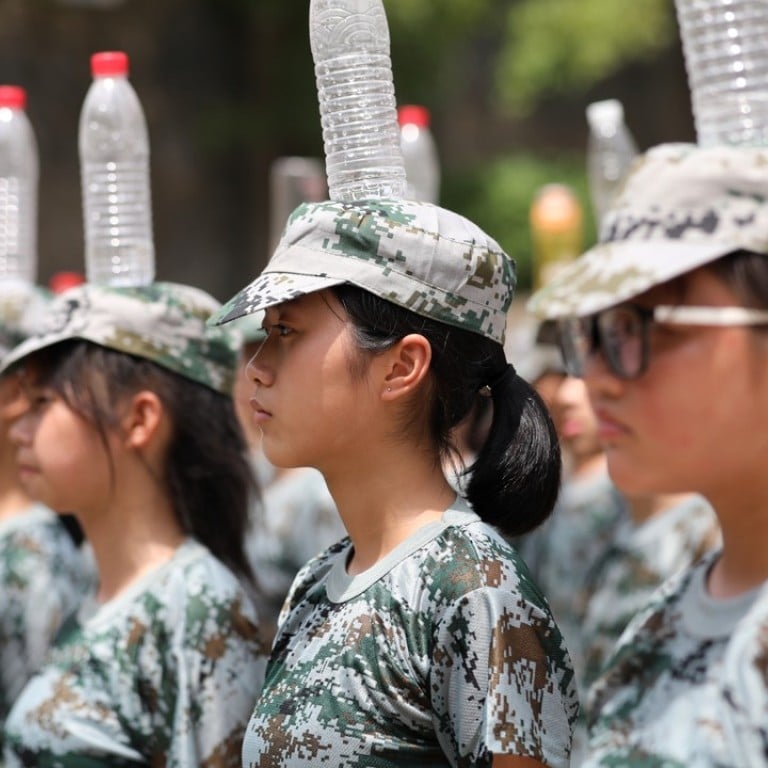
Why Chinese students have to start the academic year with a short spell of military service
A two-week spell in fatigues is an annual rite of passage for young Chinese, but it sometimes brings controversy in its wake
Every year in September, images of Chinese students from secondary schools and universities dressed in military uniforms marching in formation flood the internet.
They are the result of a Chinese rite of passage: a week or two of military service to mark the start of the academic year.
However, with equal predictability, an annual slew of controversies emerge – with students being injured, mistreated or even killed during the training, prompting critics to question whether the exercise is really necessary.
Some critics argue that the training is of little practical benefit and only a proper stint in the army can teach young people useful military skills.
But others say the programmes instil necessary discipline and perseverance in young Chinese.
What’s the danger?
This year’s most serious incident involved the death of a 15-year-old boy studying at Nanjing Technician College at the end of August.
On September 7 police in Jiangsu province announced that the teenager, identified only by his surname Wang, had died from heatstroke during a training exercise conducted in temperatures of 33 degrees Celsius (91 degrees Fahrenheit) and the high humidity of a Chinese summer.
Hong Kong and Macau students will face compulsory military training at top mainland Chinese university for first time
Police opened an investigation after the death, but were not reported to be taking any further action.
On the same day, the government of Yangxian township in Shaanxi province said an officer in charge of a training exercise had been fired ordering a group of high school pupils to dip their fingers into a pile of food waste and taste it as punishment for wasting food.

Beijing’s elite Tsinghua University has also summoned students from Hong Kong and Macau – who had previously been exempt – to take part in three weeks of compulsory training before they started their courses.
Such incidents have sparked fresh debate about the merits of these compulsory training exercises.
“There’s no need for such training, the goal of the training is solely to diminish personality and achieve obedience,” one person commented on a news report on Weibo, China’s equivalent of Twitter.
Chinese teens complain compulsory military training too difficult, but teachers say toughen up
Another wrote: “Those who are saying military training can cultivate perseverance, please stand for six hours under the sun in 35C for 13 days, then you can tell us military training is bliss.”
But another replied: “A nation can only be supported by strong-bodied youngsters, how can it be cancelled?”

How does it work?
The form of the military training varies across the country.
Most Chinese universities require first-year students to go complete a programme – usually for two weeks – at the start of the academic year.
The students study basic formations, combat skills and sometimes even learn to shoot.
Training is also mandatory for high school pupils, while some middle schools make teenagers take part in exercises.
Chinese students blacklisted for refusing to carry out compulsory military training
Military education was first written into legislation in 1984, as part of China’s Military Service Law, which declares “it is the sacred duty of every citizen of the People’s Republic of China to defend the motherland and resist aggression”.
In 1994, a new set of military education rules said the training must include theoretical as well as practical combat elements, a requirement repeated in the 2001 Law of National Defence Education.
The law makes it mandatory for students in higher education institutes to go through this basic military training.

How does it compare with other countries?
Few other countries incorporate a short burst of military training into the academic year. But unlike China, dozens of countries operate some form of conscription that requires longer stints of military service, with 32 requiring more than 18 months of service for men.
Crazy Rich Asians author Kevin Kwan wanted in Singapore for dodging mandatory national service
In Singapore, the National Service Act of 1967 requires all men over 18 to spend two years in the army.
Those who have completed their allotted time can be called up for 40 days of service every year until they reach 40.
In South Korea, where the threat from the North looms large, all able-bodied men over 18 have to do about two years of military service, with many young men forced to put their studies or careers on hold.

Young men often view the service as an unavoidable nuisance, and some “avoided the draft by forging medical records or obtaining foreign citizenship”, according to South Korean media reports. A group of music students were accused of deliberately putting on weight by overeating to ensure they failed the physical exam.
Should young Hongkongers join the PLA? Maybe it’s not a good idea at all
In Taiwan, the Ministry of National Defence assigns soldiers to high schools and universities as military instructors, to teach basic military training courses and provide campus security. But there is growing discussion of whether their role is necessary.
In 2016, the Executive Yuan, Taiwan’s cabinet, announced that military instructors would be gradually replaced by security guards.
The United States, and most of its major allies, have entirely voluntary armed forces as does Japan, where the post-war constitution puts serious limitations of the role of the military.
Russia still maintains a draft system that means that about a third of its million-strong armed forces are conscripts.

.jpg?itok=H5_PTCSf&v=1700020945)